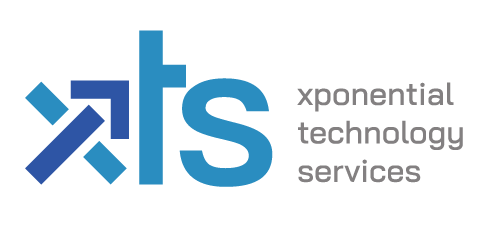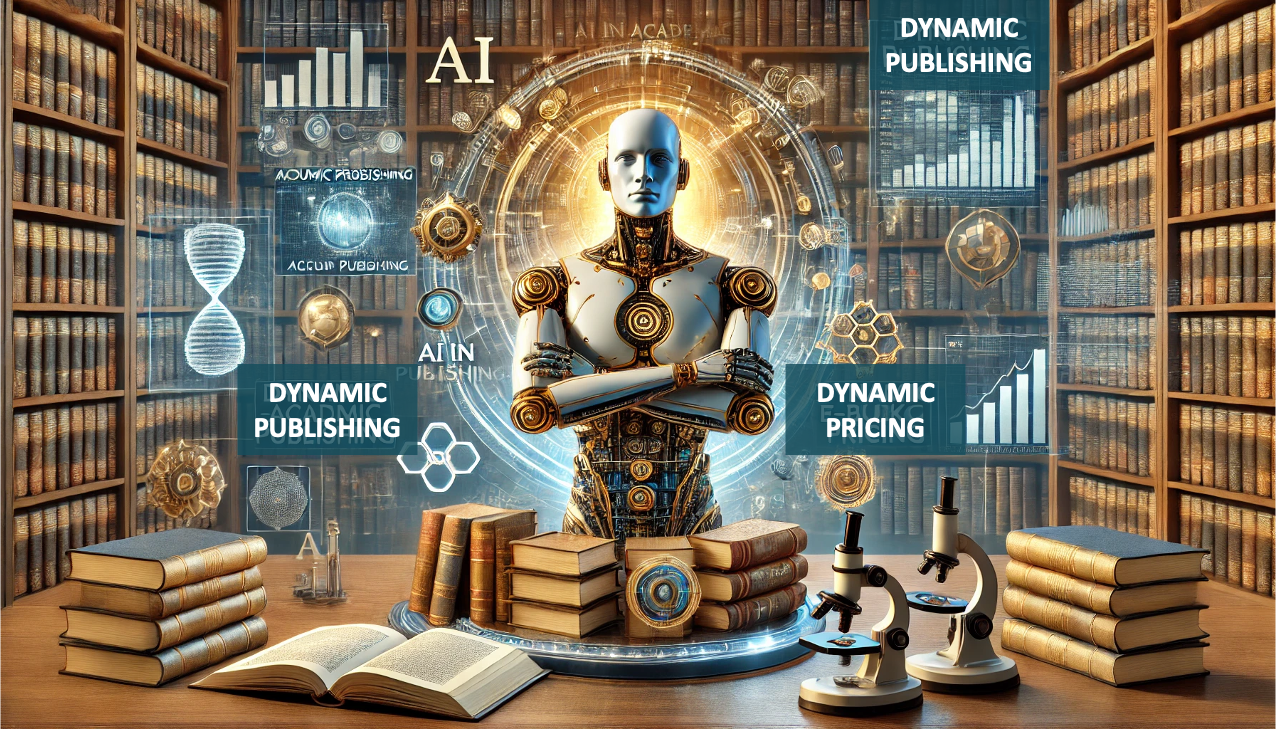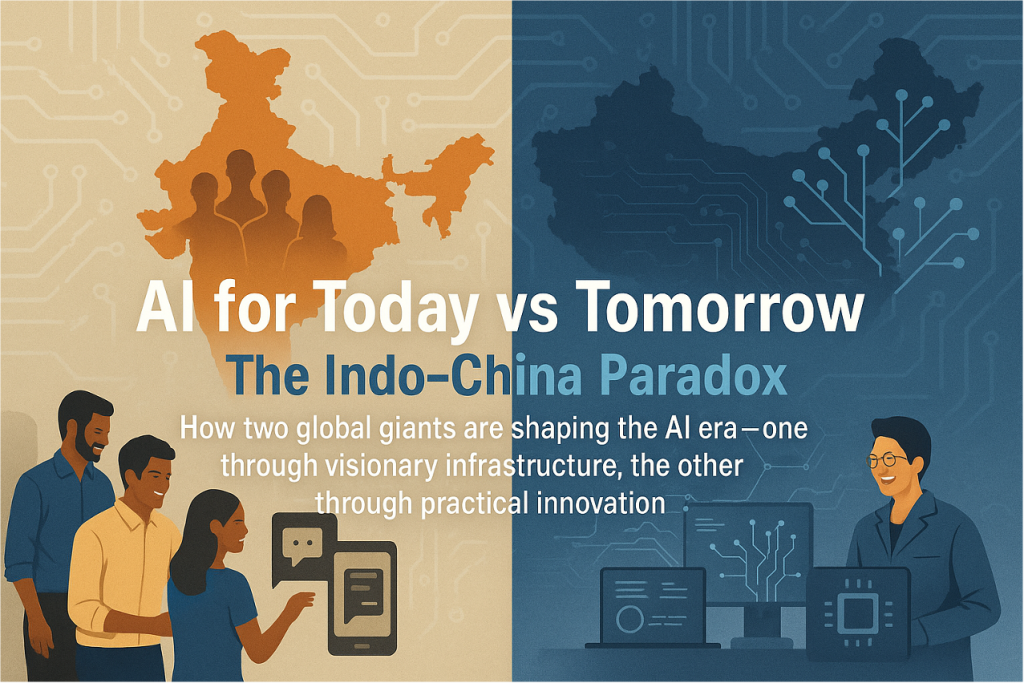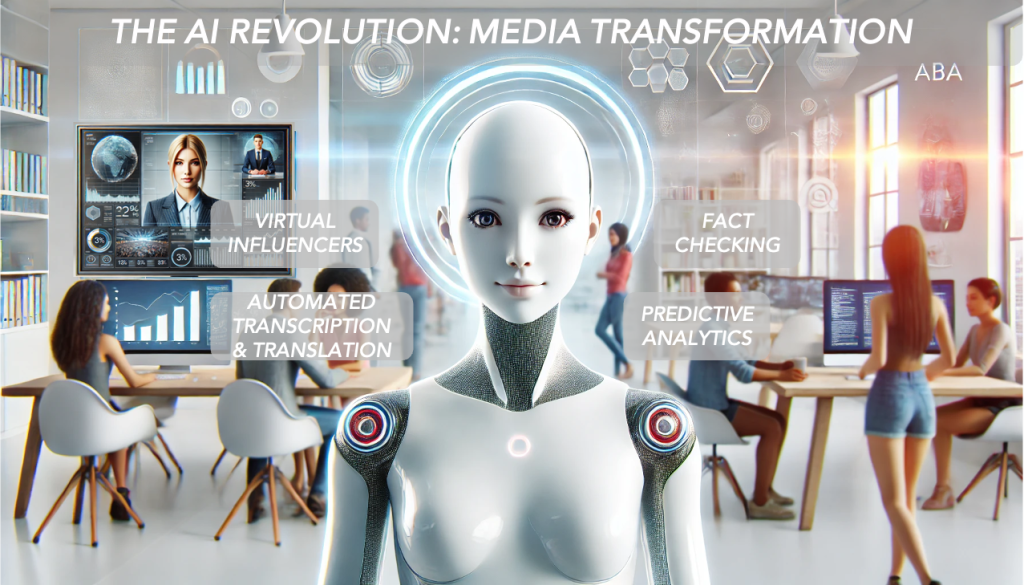Plot twist: This blog about AI in entertainment was co-authored by AI. Talk about method acting! We asked the AI to include a joke, but its humor chip is still buffering. Rest assured, all witty comments and puns are 100% human-generated. We think.
In our previous blog post, we explored how AI is revolutionizing the media landscape, from newsrooms to video production. Now, we turn our attention to another pillar of the information age: the publishing industry. Long considered a bastion of human creativity and intellectual pursuit, publishing is undergoing a profound transformation at the hands of artificial intelligence.
This second installment in our four-part series on “The Generative AI Revolution in Media, Publishing, and Entertainment” delves into how AI is reshaping the world of publishing. From traditional book publishing to academic journals and digital content platforms, AI is leaving no page unturned. Join us as we explore this brave new world where algorithms and authors collaborate to create the future of the written word.
AI Writing Coaches: Nurturing the Next Generation of Authors
The solitary writer, hunched over a typewriter, may be an enduring image of authorship, but AI is now playing the role of a tireless writing companion. Tools like ProWritingAid and AutoCrit are revolutionizing the writing process, offering real-time feedback on everything from grammar and style to plot consistency and character development.
For instance, AutoCrit’s AI analyzes successful books in various genres to provide tailored advice to authors. A romance novelist using AutoCrit reported that the tool helped her identify and rectify pacing issues in her manuscript, leading to a 20% increase in positive reviews for her latest book.
These AI writing coaches are not replacing human creativity; rather, they’re enhancing it. They’re allowing authors to focus on their stories while AI handles the technical aspects of writing. This democratization of expert writing advice could lead to a new wave of diverse voices in literature.
Automated Book Marketing: Finding the Right Reader
In today’s crowded book market, getting noticed is half the battle. AI is proving to be a powerful ally in this fight, with tools like BookBub’s Ad Optimizer and Kadaxis using machine learning to target the right readers with the right books.
Kadaxis, for example, uses AI to analyze book content and reader behavior to generate optimized metadata and book descriptions. A mid-list author who used Kadaxis saw a 37% increase in Amazon click-through rates after implementing AI-generated book descriptions.
This level of targeting goes beyond simple demographics. AI can analyze reading patterns, purchase history, and even social media activity to identify potential readers who are most likely to enjoy a particular book. It’s a win-win: readers discover books they love, and authors find their audience.
Dynamic Pricing Models: Maximizing Revenue in Real-Time
Pricing a book has always been part art, part science. Now, AI is tipping the balance towards science. Platforms like PublishDrive and Bookmetrix use AI to adjust book prices in real-time based on various factors including demand, competition, and reader behavior.
A case in point: a thriller novelist using PublishDrive’s AI pricing tool saw a 23% increase in revenue over three months. The AI dynamically adjusted the ebook’s price, lowering it to boost visibility during slow periods and raising it during high-demand times.
This dynamic pricing strategy, long used by airlines and hotels, is now available to publishers of all sizes. It allows for more responsive and optimized pricing strategies, potentially increasing both sales and revenue.
The hottest D2C trend? Subscription boxes that make Christmas morning feel like a monthly event. From artisanal coffee to gourmet dog treats, there’s a box for every niche. It’s not just convenient; it’s like having a personal shopper with really good taste!
AI-Powered Hypothesis Generation: Charting New Research Territories
One of the most exciting applications of AI in academic publishing is its ability to generate new research hypotheses. Systems like IBM Watson for Drug Discovery and BenevolentAI are analyzing vast amounts of scientific literature to suggest novel research directions.
BenevolentAI, for instance, used its AI system to identify a potential Coronavirus treatment in early 2020. By analyzing connections between drug data and viral mechanisms, it identified a rheumatoid arthritis drug as a potential COVID-19 treatment, a hypothesis that was later confirmed in clinical trials.
This AI-assisted approach to hypothesis generation could significantly accelerate the pace of scientific discovery. It allows researchers to identify promising avenues of inquiry that might be overlooked by human analysis alone.
Automated Systematic Reviews: Synthesizing Knowledge at Scale
Systematic reviews, which synthesize findings from multiple studies, are crucial for evidence- based practice but are notoriously time-consuming. AI tools like Nested Knowledge and RobotReviewer are streamlining this process.
RobotReviewer can analyze thousands of clinical trial reports, extracting key information and assessing the risk of bias in each study. In a recent project, it processed 1,000 clinical trial reports in just a few hours, a task that would typically take a team of researchers several weeks.
By automating the initial stages of systematic reviews, AI frees up researchers to focus on interpretation and application of findings. This could lead to more frequent updates of clinical guidelines and faster translation of research into practice.
Intelligent Plagiarism Detection: Safeguarding Academic Integrity
As the volume of academic publications grows, so does the challenge of maintaining academic integrity. Advanced AI systems like Turnitin and Copyleaks are rising to meet this challenge, using natural language processing to detect not just verbatim copying, but also paraphrased content and idea theft.
Copyleaks, for example, uses AI to understand context and meaning, allowing it to identify plagiarism even when the text has been significantly reworded. A recent study found that Copyleaks detected 28% more instances of potential plagiarism compared to traditional similarity-checking tools.
These AI systems are not just policing academic honesty; they’re also educational tools. By providing detailed feedback on citation and paraphrasing, they’re helping students and researchers better understand academic writing conventions.
Adaptive Learning Content: Personalizing Education at Scale
In the realm of educational publishing, AI is enabling a shift from one-size-fits-all textbooks to adaptive learning experiences. Platforms like Knewton and Carnegie Learning use AI to create educational materials that adjust in real-time based on a student’s performance.
For instance, Carnegie Learning’s AI-powered math curriculum analyzes each student’s responses to provide personalized feedback and adjust the difficulty of subsequent questions. Schools using this system reported a 12% improvement in math test scores after one year of implementation.
This adaptive approach allows for truly personalized learning experiences, potentially revolutionizing education. It’s not just about delivering content; it’s about understanding how each student learns and adapting accordingly.
Collaborative AI Editors: Harmonizing Multi-Author Works
In an era of collaborative knowledge creation, maintaining consistency across multi-author works can be challenging. AI tools like Grammarly Business and Qordoba are stepping in to help, using natural language processing to ensure consistency in style, terminology, and tone across large documents.
Qordoba’s AI, for example, can learn a company’s style guide and automatically flag deviations in any document. A tech company using Qordoba reported a 40% reduction in editing time for their technical documentation, along with improved consistency across their knowledge base.
These tools are particularly valuable for large organizations producing extensive documentation, or for academic publishers managing multi-author textbooks. They ensure a unified voice while still allowing for individual expression.
Real-Time Content Updating: The End of Static Publications
In the fast-paced digital world, information can become outdated quickly. AI services like Automated Insights and Narrative Science are enabling the creation of “living” documents that update automatically as new information becomes available.
Automated Insights’ Wordsmith platform, for instance, is used by the Associated Press to generate real-time financial reports. These reports update automatically as new data comes in, ensuring readers always have the most current information.
This capability is extending beyond news to other forms of publishing. Imagine textbooks that update with the latest research findings, or travel guides that adjust their recommendations based on current events. AI is making this dynamic content a reality.
As we’ve seen, AI is not replacing the core functions of publishing; it’s augmenting and enhancing them. From nurturing authors to safeguarding academic integrity, from personalizing educational content to enabling real-time updates, AI is expanding the possibilities of what publishing can be.
However, this AI revolution also raises important questions. How do we maintain the human touch in an increasingly automated publishing landscape? How do we ensure that AI- assisted content creation doesn’t lead to homogenization? And how do we address the ethical implications of AI in academic publishing?
These are the challenges that will shape the future of publishing in the age of AI. As we continue to integrate these powerful tools into the world of books, journals, and digital content, we must remain mindful of both their potential and their pitfalls.
In our next blog post, we’ll explore how AI is transforming the entertainment industry, from film and television to gaming and music. Stay tuned for “Entertainment Evolved: AI as the Ultimate Creative Partner,” where we’ll dive into the world of AI-generated content, personalized entertainment experiences, and the future of interactive storytelling.
The written word has always been a driving force of human progress. With AI as our new collaborator, we’re turning the page to an exciting new chapter in the story of publishing.






